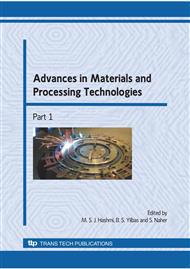[1]
W. Grzesik, Experimental investigation of the cutting temperature when turning with coated indexable inserts, International Journal of Machine Tools & Manufacture, 39 (1999), 355-369.
DOI: 10.1016/s0890-6955(98)00044-3
Google Scholar
[2]
M.B. de Silva and J. Wallbank, Cutting temperature: prediction and measurement methods - a review, Journal of Material Processing Technology, 88 (1999), 195-202.
DOI: 10.1016/s0924-0136(98)00395-1
Google Scholar
[3]
D. O'Sullivan and M. Cotterell, Temperature measurement in single point turning, Journal of Material Processing Technology, 118 (2001).
Google Scholar
[5]
W. König, R. Fritsch, and D. Kammermeier, New approaches to characterizing the performance of coated cutting tools. Annals of CIRP, 41(2), (1992), 49.
DOI: 10.1016/s0007-8506(07)61150-0
Google Scholar
[6]
T. Cselle and A. Barimani, Today's applications and future developments of coatings for drills and rotating cutting tools, Surface and Coating Technology, 76-77, (1995), 712.
DOI: 10.1016/0257-8972(96)80011-9
Google Scholar
[7]
M.C. Shaw, Metal cutting principles, Oxford University Press, London, ISBN 0-19-859002-4, (1984), 594.
Google Scholar
[8]
D. Stephenson, Assessment of steady-state metal cutting temperature models based on simultaneous infrared and thermocouple data, ASME Journal of Engineering Industry, 113, (1991), 121-128.
DOI: 10.1115/1.2899668
Google Scholar
[9]
D. Stephenson, T. Jen, and A. Lavine, Cutting tool temperatures in contour turning: Transient analysis and experimental verification, ASME Journal of Engineering Industry, 119, (1997), 494-501.
DOI: 10.1115/1.2831179
Google Scholar
[10]
D. Antonelli, D. Romano, and N. Bellomo, Computation of thermal field in tools during machining processes, Mathematical Computation Modelling, 21(5), (1995), 53-68.
DOI: 10.1016/0895-7177(95)00039-5
Google Scholar
[11]
W.D. James, F.R. William, and G.M. Kenneth, Instrumentation for engineering measurement, 2nd ed, John Wiley and Sons, 428-463.
Google Scholar
[12]
G. Byrne, Thermocouple signal characteristics and average interfacial temperature in the machining of metals under geometrically defined condition, International Journal of Machine Tools & Manufacture, 27(2), (1987), 215-224.
DOI: 10.1016/s0890-6955(87)80051-2
Google Scholar
[13]
D.A. Stephenson, Assessment of steady-state metal cutting temperature models based on simultaneous infrared and thermocouple data, ASME Journal of Engineering Industry, 113, (1991), 121-128.
DOI: 10.1115/1.2899668
Google Scholar
[14]
P. Lezanski and M.C. Shaw, Tool face temperatures in high speed milling, ASME Journal of Engineering Industry, 112(2), (1990), 132-135.
DOI: 10.1115/1.2899555
Google Scholar
[15]
E.M. Trent, Metal cutting, 3 rd edition, Butterworth, London, ISBN 0750610689, (1991).
Google Scholar
[16]
D.A. Cozzens, J.W. Sutherland, and W.W. Olson, An investigation into the cutting fluid effects on temperature in the aluminium boring, SME MR 95-210, in: Proc. Of the First International Machining and Grinding Conference, (1995), 881-891.
Google Scholar
[17]
R.C. Dewes, E. Ng, K.S. Chua, P.G. Newton, and D.K. Aspinwall, Temperature measurement when high speed machining hardened mould/die steel, Journal of Material Processing Technology, 92-93, (1991), 293- 301.
DOI: 10.1016/s0924-0136(99)00116-8
Google Scholar
[18]
H.T. Young, Cutting temperature responses to flank wear, Wear, 201, (1996), 117-120.
DOI: 10.1016/s0043-1648(96)07227-4
Google Scholar
[19]
L. Wang, K. Satio, and I.S. Jawahir, Infrared temperature measurement of curled chip formation in metal cutting, Trnans. 'AMRI/SME XXIV, (1996), 87-92.
Google Scholar
[20]
L. Yourong, L. Jiajun, Z. Baoliang, and D. Zhi, Temperature distribution near cutting edge of ceramic cutting tools measured by thermal video system (TVS), Prog. 'ational Science, 8(1), (1998), 44-50.
Google Scholar
[21]
G. Boothroyd, Temperatures in orthogonal metal cutting, Proc. Instn. of Mechanical Engineers, 177(29), (1963), 789-802.
Google Scholar
[22]
J.P. Kottenstette, Measuring tool-chip interface temperatures, Journal of Engineering Industry, (Transc. ASME), 108(2), (1986), 101-104.
DOI: 10.1115/1.3187043
Google Scholar
[23]
T. Kitagawa, A. Kubo, and K. Maekawa, Temperature and wear of cutting tools in high-speed machining of Inconel 718 and Ti-6Al-2Sn, Wear, 202, (1997), 142-148.
DOI: 10.1016/s0043-1648(96)07255-9
Google Scholar
[24]
G. Palazzo and R. Pasquino, Temperature Fields in Machining Process and Heat Transfer Models, Mathematical and Computer Modeling, 35, (2002), 101-109.
DOI: 10.1016/s0895-7177(01)00152-2
Google Scholar


